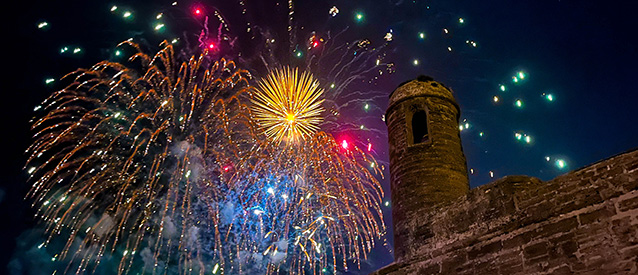
NPS/V STAUFFENBERG
The celebration of Independence Day is full of festivities and traditions. Fireworks, parades, and barbecues are often included in planning for this ultimate summer holiday. A trip to the emergency room is usually not on your list. Keeping fire safety in mind ensures your Fourth of July event is fun and memorable for all the right reasons.
Even though fireworks related fires, deaths, and injuries are preventable, the statistics are scary. In 2023 alone, the National Fire Prevention Association (NFPA) reported 32,302 fires caused by fireworks, including 3,760 structure fires, 849 vehicle fires, and 27,252 outside fires. Last year, the U.S. Consumer Product Safety Commission (CPSC) reported 11 fireworks-related deaths and 14,700 people injured, a 38% increase in deaths and a 52% increase in injuries respectively compared to 2023. An estimated 1,700 injuries were related to sparklers alone. Burns were 37% of all emergency room visits. Ensure you and your family and friends don’t become statistic.
Stay safe by following these precautions:
- Review your community’s local regulations to determine where fireworks are allowed to be used and what types of fireworks are acceptable. Many communities ban dangerous fireworks for a simple reason, they’re dangerous. Only purchase fireworks labeled for consumer, not professional use.
- Avoid the use of fireworks in the wildland-urban interface to prevent wildland fires.
- Never allow young children to play with or ignite fireworks. While sparklers are pretty, they burn at estimated temperatures of 2,000 degrees Fahrenheit, which is hot enough to melt some metals.
- Keep a bucket of water or a charged garden hose nearby to extinguish any small fires.
- Wear safety glasses while lighting fireworks and keep spectators at a safe distance.
- Don’t re-light or pick up fireworks that have not ignited fully.
- Refrain from lighting fireworks while under the influence. Alcohol and fireworks don’t mix.
- Dispose of spent fireworks by soaking in water in a metal trash can overnight, away from buildings.
You don’t need to light your own fireworks to have a good time. Consider attending a professional fireworks event organized by your local community. Many are timed to patriotic music and are a sight to behold. Enjoy your Independence Day celebration safely!
Employees
Using or possessing fireworks within the boundaries of a National Park Service site is prohibited according to 36 CFR 2.38 (b). However, the superintendent may provide a special use permit for a professional display during a special event in accordance with the Code of Federal Regulations (CFR), NPS policy, and adopted fire codes and standards. Visitors and employees living in the parks should not possess or use fireworks.
When celebrating with fireworks outside your park, remember to be prepared, be safe and be responsible.
Park Leadership
Are your park employees and visitors aware of the regulations? Do environmental conditions such as high fire danger warrant additional staffing for fire response? Do park employees know the differences between consumer fireworks and homemade explosive devices? Ensure that all park visitors are aware of the regulations and ensure staff report violations to proper law enforcement personnel.
Last updated: July 2, 2025
